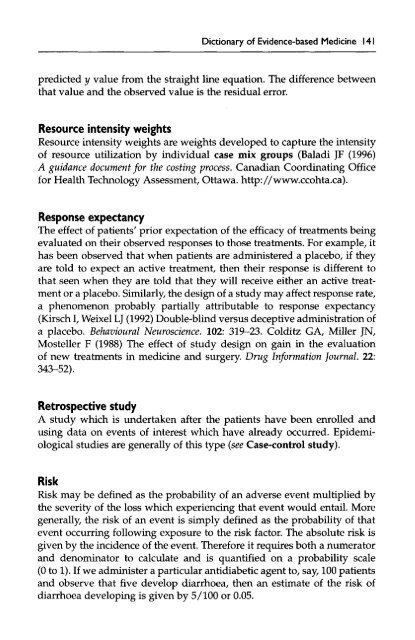Dictionary of Evidence-based Medicine.pdf
Dictionary of Evidence-based Medicine.pdf
Dictionary of Evidence-based Medicine.pdf
Create successful ePaper yourself
Turn your PDF publications into a flip-book with our unique Google optimized e-Paper software.
<strong>Dictionary</strong> <strong>of</strong> <strong>Evidence</strong>-<strong>based</strong> <strong>Medicine</strong> 141<br />
predicted y value from the straight line equation. The difference between<br />
that value and the observed value is the residual error.<br />
Resource intensity weights<br />
Resource intensity weights are weights developed to capture the intensity<br />
<strong>of</strong> resource utilization by individual case mix groups (Baladi JF (1996)<br />
A guidance document for the costing process. Canadian Coordinating Office<br />
for Health Technology Assessment, Ottawa, http://www.ccohta.ca).<br />
Response expectancy<br />
The effect <strong>of</strong> patients' prior expectation <strong>of</strong> the efficacy <strong>of</strong> treatments being<br />
evaluated on their observed responses to those treatments. For example, it<br />
has been observed that when patients are administered a placebo, if they<br />
are told to expect an active treatment, then their response is different to<br />
that seen when they are told that they will receive either an active treatment<br />
or a placebo. Similarly, the design <strong>of</strong> a study may affect response rate,<br />
a phenomenon probably partially attributable to response expectancy<br />
(Kirsch I, Weixel LJ (1992) Double-blind versus deceptive administration <strong>of</strong><br />
a placebo. Behavioural Neuroscience. 102: 319-23. Colditz GA, Miller JN,<br />
Mosteller F (1988) The effect <strong>of</strong> study design on gain in the evaluation<br />
<strong>of</strong> new treatments in medicine and surgery. Drug Information Journal. 22:<br />
343-52).<br />
Retrospective study<br />
A study which is undertaken after the patients have been enrolled and<br />
using data on events <strong>of</strong> interest which have already occurred. Epidemiological<br />
studies are generally <strong>of</strong> this type (see Case-control study).<br />
Risk<br />
Risk may be defined as the probability <strong>of</strong> an adverse event multiplied by<br />
the severity <strong>of</strong> the loss which experiencing that event would entail. More<br />
generally, the risk <strong>of</strong> an event is simply defined as the probability <strong>of</strong> that<br />
event occurring following exposure to the risk factor. The absolute risk is<br />
given by the incidence <strong>of</strong> the event. Therefore it requires both a numerator<br />
and denominator to calculate and is quantified on a probability scale<br />
(0 to 1). If we administer a particular antidiabetic agent to, say, 100 patients<br />
and observe that five develop diarrhoea, then an estimate <strong>of</strong> the risk <strong>of</strong><br />
diarrhoea developing is given by 5/100 or 0.05.










